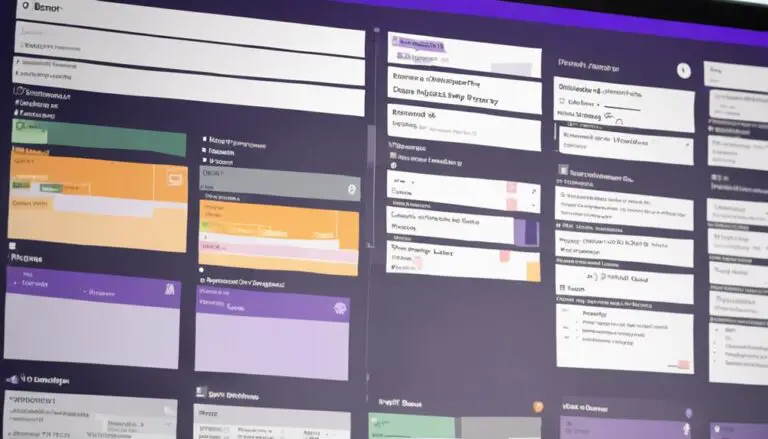In the realm of project management methodologies, there lies a strategy that combines the best of both worlds: Scrum and Kanban. Picture a scenario where the flexibility of Scrum and the visual clarity of Kanban are seamlessly intertwined, unlocking a realm of possibilities for team efficiency and success.
Imagine the potential for heightened productivity and streamlined workflows when these two powerful tools converge. The synergy between Scrum and Kanban offers a tantalizing glimpse into the realm of concurrent success, promising a harmonious blend of methodologies that could revolutionize your team's approach to project management.
Key Takeaways
- Combine Scrum and Kanban for optimized project efficiency and collaboration.
- Utilize metrics like WIP limits and cycle time for insights and improvement.
- Foster adaptability and responsiveness to changes for same-time success.
- Streamline workflow, enhance communication, and prioritize tasks for team efficiency.
Benefits of Combining Scrum and Kanban
By merging Scrum and Kanban, you unlock a powerful synergy that boosts collaboration and project efficiency. Agile teams benefit from the structured framework of Scrum with its defined roles, ceremonies, and iterative approach, while also leveraging Kanban's visual workflow management and flexibility.
This combination allows teams to adapt quickly to changes, visualize their work in progress, and identify bottlenecks efficiently. By integrating these methodologies, teams can enhance communication, foster a collaborative environment, and increase productivity.
The collaboration between Scrum and Kanban not only streamlines workflow but also improves overall efficiency, enabling teams to deliver high-quality results consistently. Embracing the strengths of both methodologies leads to enhanced adaptability in managing complex projects and empowers teams to work together seamlessly towards achieving their goals.
In essence, combining Scrum and Kanban offers a holistic approach that maximizes team performance and ensures successful project outcomes.
Implementing Scrum and Kanban Together
To effectively implement Scrum and Kanban together, consider leveraging their complementary strengths to optimize team performance and efficiency. Scrum teams use the Kanban method to enhance their workflow by implementing WIP limits, visualizing the work process, and focusing on the flow of value.
By incorporating Kanban practices such as limiting work in progress, teams can increase efficiency and reduce bottlenecks. Metrics like cycle time and lead time play a crucial role in assessing the impact of combining Scrum and Kanban on team productivity. Visualizing the workflow not only aids in identifying areas for improvement but also facilitates better decision-making based on real-time insights.
Evaluating lead time and cycle time helps in understanding the team's agility and responsiveness when implementing both methodologies concurrently. By embracing Kanban principles within Scrum environments, teams can streamline processes, enhance transparency, and achieve higher levels of efficiency.
Enhancing Team Collaboration With Scrum and Kanban
Enhance team collaboration seamlessly by integrating the principles of Scrum and Kanban into your workflow. Scrum promotes collaboration through its cross-functional teams that work together in time-boxed sprints. This method emphasizes collaboration in various stages like sprint planning, review, and retrospective meetings.
On the other hand, Kanban enhances collaboration by visualizing workflow stages, promoting continuous delivery, and providing real-time visibility of work progress and bottlenecks. By combining these approaches, teams can benefit from improved communication and transparency.
Utilizing Kanban boards and Scrum ceremonies can help teams stay organized, focused, and aligned on common goals. The visual nature of Kanban boards aids in understanding workflow status at a glance, while the structured sprint planning of Scrum ensures that everyone is on the same page. This integration fosters a collaborative environment where team members can work together efficiently towards achieving project milestones.
Maximizing Workflow Efficiency
Maximizing workflow efficiency is crucial for driving productivity and achieving optimal results when integrating Scrum and Kanban practices. By leveraging the strengths of both frameworks, teams can enhance their workflow efficiency in agile project management.
Here's how:
- Using Visual Management: Integrating Scrum's sprint structure with Kanban's visual workflow management allows teams to have a clear overview of tasks, progress, and priorities. This visual representation enhances transparency and communication within the team.
- Limiting Work in Progress: Implementing Kanban's principle of limiting work in progress helps teams focus on completing tasks efficiently before moving on to new ones. This approach reduces multitasking, minimizes delays, and improves overall workflow efficiency.
- Online Kanban for Continuous Improvement: Adopting online Kanban tools facilitates real-time monitoring of work progress and enables teams to identify bottlenecks promptly. This continuous improvement cycle allows for adjustments to be made swiftly, leading to a smoother and more effective software development process.
Achieving Same-Time Success With Scrum and Kanban
Achieve same-time success by seamlessly integrating Scrum and Kanban practices to optimize team efficiency and productivity. By combining the collaborative and iterative approach of Scrum with the visual management and flow-based principles of Kanban, teams can effectively prioritize tasks, reduce waste, and improve overall project delivery. The scrum and kanban integration allows for better visibility and transparency, enabling teams to identify bottlenecks, react quickly to changes, and continuously improve their processes. This integration also promotes a culture of continuous learning and adaptation, leading to higher quality outcomes and greater customer satisfaction.
By combining Scrum's iterative approach with Kanban's workflow optimization, teams can effectively tackle complex projects. Utilizing metrics such as WIP limits and cycle time provides insights into the workflow, enabling teams to make data-driven decisions for improved performance.
The integration of Scrum and Kanban fosters a culture of continuous improvement and value delivery, ensuring that teams remain adaptable and responsive to changing project requirements. This approach not only enhances team efficiency but also streamlines the overall workflow, leading to better outcomes.
Frequently Asked Questions
Can You Use Kanban and Scrum at the Same Time?
Yes, you can use Kanban and Scrum concurrently for agile collaboration, team synchronization, workflow optimization, task prioritization, iterative planning, continuous improvement, visual management, flexibility in process, and productivity enhancement. This approach leverages the strengths of both methodologies for enhanced efficiency.
What Technique Combines the Methodology of Scrum and Kanban?
To combine Scrum and Kanban methodologies, use Scrumban, a technique blending agility of Scrum with simplicity of Kanban. It aids in continuous improvement, team collaboration, visual management, daily standups, limiting WIP, iterative development, backlog refinement, and sprint planning seamlessly.
How Do You Establish Flow With Scrum and Kanban?
To establish flow with Scrum and Kanban, you focus on visual management, set Work in Progress limits, and measure cycle time. By enhancing collaboration, optimizing processes, and managing backlogs effectively, you continuously improve team dynamics for success.
What Are Possible Benefits of Supplementing Scrum With Kanban Practices?
When you blend Scrum with Kanban, you unlock a powerhouse duo. Enjoy improved collaboration, increased productivity, and streamlined processes. Witness enhanced visibility, better prioritization, and continuous improvement. Say goodbye to bottlenecks and revel in faster delivery with an efficient workflow.
Conclusion
In conclusion, integrating Scrum and Kanban is like combining the precision of a surgeon with the creativity of an artist. By leveraging the strengths of both methodologies, teams can streamline workflows, boost collaboration, and achieve remarkable efficiency.
Embrace the power of Scrum and Kanban working together to reach new heights of success in your projects. Your team's potential is limitless when these two methodologies are harmoniously united.





